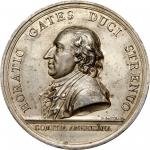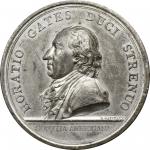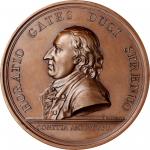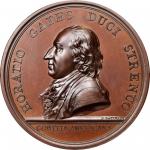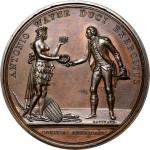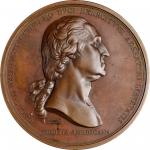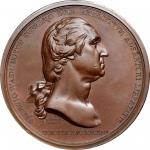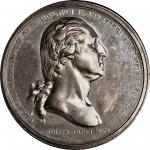1776 (ca. 1863-85) Washington Before Boston medal. Betts-542, Julian MI-1, Musante GW-09-US1, Baker-49, Mooney M15. Copper. Bell-metal (i.e. “gunmetal”) transfer dies. Philadelphia Mint. 67.8 mm, 2456.6 grains. 7.0 - 7.3 mm thick. About Uncirculated.Plain square edge. Light mahogany brown with the distinctive texture of a "gunmetal" strike. The fields are rippled and uneven, the reverse devices a bit indistinct, and the rims are high and wide. The planchet is far thicker than any other sort of Washington Before Boston medal. The surfaces are glossy but not lustrous, with an even and attractive applied patina. This specimen shows some light surface verdigris, most notable around the periphery of the portrait bust and between the bottom of the queue and the word COMITIA, although some shallower patches are seen elsewhere. A few scattered marks are seen, but only a horizontal mark far below FU of FUGATIS is prominent. A light rim bruise at 9:00 on the obverse joins two small rim ticks above TIS of FUGATIS. The visual appeal is quite nice overall.<p>This is a rare medal. The first recorded delivery from these dies was 10 pieces in 1864. By the time these dies had deteriorated beyond usefulness in the first half of 1885, a total of 145 bronzes had been struck (and one example in silver). The biggest single year mintage was 37 in 1868. <p>As noted in our essay on bell metal dies (see below), the very origin of the term "gunmetal" - incorrect, as Craig Sholley has painstakingly proven - comes from Bakers 1885 description of these pieces. The mother medal for these transfer dies was a contemporary French restrike, cataloged as Baker-48 or Musante GW-09-P3, using the original obverse with the third Paris Mint reverse. The most common form of that restrike is seen with a Pointing Hand edge mark, denoting a striking date in Paris between 1845 and 1860. The 20 medals that the Paris Mint sent to Philadelphia in the spring of 1862 may have been marked with the Pointing Hand, or they could have been marked with the Bee privy mark (in use from 1860 to 1879). When the transfer dies were made, the spalling pits were carefully removed from the fields, and lapping lines are seen where the heavy break was once built up between the top of E in ADSERTORI and the inside step of the rim. While Julian noted "this transfer did not include the lettering and it had to be punched in separately," the positional idiosyncrasies of the lettering on both sides matches the mother medal exactly. Some touch ups may have been required, but this medal is a complete transfer from the Paris originals. The later U.S. Mint copy dies (see next lot) do show freshly punched legends, and only their central motifs were lifted from the Paris mothers.<p>As the very first variety of Washington Before Boston medal produced in the United States, struck during the boom of interest in American numismatics generally and Washington material (and medals) more specifically, this scarce variety deserves more interest and demand than it gets. These medals are at least a magnitude rarer than their contemporary Paris Mint restrike counterparts.<p><strong>The Philadelphia Mint Comitia Americana Medals from Bell Metal Dies</strong><p>Even though coin collecting did not fully blossom into a national hobby until the end of the 1850s, medal collecting had a dedicated following even from the era of the Revolution. Pioneering specialized works on early American medals by Dr. James Mease (1821), J. Francis Fisher (1837), Thomas Wyatt (1848), all preceded Benson J. Lossings popular history <em>A Pictorial Field-Book of the Revolution,</em> which was published serially beginning in 1850 and on its own in 1853. Lossings work introduced many Americans to the Comitia Americana series within their historical context, offering accurate illustrations to would-be collectors who may never have known such things existed otherwise.<p>The U.S. Mint began producing medals for sale to a collector clientele by the early 1840s. By 1841, Chief Coiner Franklin Peale had inventoried the medal dies on hand at the Philadelphia Mint, and soon thereafter he began making electrotypes to satisfy collector demand. The August 3, 1844, issue of the Niles Weekly Register, a nationally distributed newspaper, ran the list of medal dies Peale had on hand, which included only Horatio Gates (added to the Mint collection in 1801) and Daniel Morgan (acquired from Paris in 1840) from the Comitia Americana series. But the Mint also offered electrotypes of Washington Before Boston, Anthony Wayne, De Fleury, William Washington, John Eager Howard, Nathanael Greene, and John Paul Jones. The Lee obverse was discovered at some point in the next decade or so, as Mint Director Snowden included it on a list of dies held by the Mint that was published in the Report of the Director of the Mint in 1854. He noted that the reverse was "(Not in the mint)."<p>When the large cent series ended in 1857, provoking nostalgia and a newfound interest in saving old coins, an upswell in collector-oriented literature spread word of the world of numismatics all over the country. Local newspapers ran columns and widely-read magazines like Harpers included numismatic content. In 1860, Mint Director James Ross Snowden published a book on the contents of the Mints coin cabinet, then followed that effort a year later with his <em>A Description of the Medals of Washington, of National and Miscellaneous Medals, and of Other Objects of Interest in the Museum of the Mint.</em> Snowdens book offered accurate images of the medals to the Mints growing retail clientele, which seemed to create exactly the byproduct Snowden wished, demand for the Mints most profitable product line: medals.<p>It is perhaps no coincidence than the Mint sought to capitalize upon this demand as best they could. The late 1850s and early 1860s saw many new medals added to the Mints list, including several new Washington-related medals (Snowdens pet interest). Cognizant that the U.S. Mint should be able to sell the medals authorized by the Continental Congress, at some point in 1861, James Pollock, the former governor of Pennsylvania who had taken over as Mint Director, wrote to the Paris Mint to request the French government forward the original dies to all American medals they held. The French, understandably, declined, but the Paris Mint was kind enough to sell the anxious Americans 20 specimens each of four medals: the Washington Before Boston, William Washington, John Eager Howard, and John Paul Jones. These medals arrived in Philadelphia in March 1862.<p>While a fixed supply was undoubtedly nice to have, Pollock wanted to control the means to produce these medals for the growing legions of new customers. He thus ordered the engraving department to produce new dies, hubbed from the medals newly arrived from Paris. A medal made of relatively soft copper would not work as a hub for a die made of steel, thus a composition softer than copper would need to be used to make the dies.<p>These dies have been called the "gunmetal" dies for more than a century, though as numismatist (and metallurgist) Craig Sholley wrote in the August 2018 issue of <em>The Numismatist</em>, the term is a misnomer. Sholley traced the first use of the term "gunmetal" to William Spohn Bakers 1885 <em>Medallic Portrait of Washington.</em> Baker described the first Washington Before Boston medals struck at the Philadelphia Mint and offered this story on their origin:<p><em>This medal furnished at the United States Mint, is struck from gun metal dies made in 1860 from a medal with the second reverse. The manner of making these dies is as follows. The medal is submitted to a heavy pressure from gun metal heated almost into a state of fusion [melting], thus conveying to the metal in intaglio the obverse and reverse of the original piece, and forming dies from which the mint medals are struck. </em><p>As Sholley noted, with this information appearing in no previous publication, it is likely that the Philadelphian Baker received it directly from a friend at the Philadelphia Mint. <p>Sholley dug into the Mint records and found that the Mint had paid John Joseph Charles Smith of Covington, Kentucky $250 in March 1860 for "the right to use his process for impressing dies in bell-metal." Bell-metal was defined in Smiths initial patent application as an alloy of 70% copper with 30% tin, the tin making the alloy softer than the copper that would be used for hubbing. The process placed the soft-metal dies into a "wrought-iron or cast-iron collar" that would keep the pressure of hubbing from completely flattening the dies.<p>After the Mint acquired rights to Smiths invention, he innovated further, changing the alloy of the dies to 1/3 copper, 1/3 zinc, and 1/3 antimony. Smith also moved to Philadelphia, apparently to oversee this process. He created a system whereby the soft-metal dies would initially be cast with the design elements, then hubbed for further relief and sharpness of detail.<p>Studying the "gunmetal" (i.e. bell metal) productions themselves, this process explains the uniquely textured surfaces, the squared off rims, and the slightly mushy detail compared to the originals.<p>In 1863, the Philadelphia Mint prepared new bell metal dies for the Washington Before Boston, William Washington, John Eager Howard, and John Paul Jones medals. These dies did not last long. The dies for the Washington Before Boston medal survived until 1885, striking 145 pieces, the largest mintage of any of the four bell metal die marriages. The William Washington dies also survived well, striking 77 pieces before they were replaced after the 1884/85 fiscal year. Just 50 examples were struck from the John Paul Jones dies before they were replaced by steel copies, 25 struck in 1863 and 25 more in 1868. Only 36 John Eager Howard medals were struck from the bell metal dies, all coined between 1871 and 1879. There exists an extremely rare Howard muling that marries the gunmetal obverse with the new copy reverse; these were likely all or part of the 13 pieces struck in 1879.<p>With proper study, the bell metal Comitia Americana medals become easy to discern from Paris Mint strikes or later copies. Medals struck at the Paris Mint after 1842 all have edge markings, so those are easy to identify. Those struck before 1842 (usually termed "originals") have distinctively reflective surfaces that are always smooth, relatively thin planchets, edges that are either concave or gently rounded at the rims, and incredibly crisply struck detail. The later Philadelphia Mint strikes from copy dies show typefaces that are very different from those seen on the Paris Mint dies and their bell metal copies, even though the central design elements are more or less the same. Since the designs of the bell metal copies are essentially the same as their Paris Mint progenitors, texture and style tells the story: surfaces that are glossy at best or even matte, but never reflective; an applied bronzed patina, usually mahogany in color, that is unlike any ever used in Paris; a very square edge, usually significantly thicker than that seen on Paris Mint strikes, and mushy fine details that are especially lacking in sharpness at their peripheries. The bell metal strikes are often slightly smaller in diameter than the Paris Mint originals as well.<p>The Philadelphia Mint bell metal Comitia Americana series is short - just four medals - but is an important chapter in the series. They are the first examples of those four medals ever struck in the United States. They were coined just as medal collecting became central to American numismatics and, more broadly, one of Americas most popular hobbies. Their mintages are tiny, far smaller than Paris Mint restrikes or even Paris Mint originals, but their value in the marketplace has not yet caught up to their rarity. Had the Julian book given them different numbers than the later copy dies (they are entirely different medals, after all), the collector market for them might be far different. When the Julian masterwork that has guided this part of the hobby for decades gets updated, this would be a vital edit that could extend the life of that reference for another century.<p><p><strong>The Taking of Dorchester Heights</strong><p><p><strong>The Action:</strong><p>The story of the American Revolution begins in Boston. Once the first garrisons of British regulars were established in Boston in 1768 - a response to Boston patriots notorious opposition to the Sugar Act and Stamp Act - progress toward outright rebellion was quick. The Boston Massacre of March 1770 and the Boston Tea Party of December 1773 were preludes to armed conflict, which began in April 1775 with the battles of Lexington and Concord. <p>General Thomas Gage, the Commander in Chief of British forces in North America, arrived in Boston in May 1774, not quite a year before shots were fired on Lexington Green. He was appointed Royal Governor of the colony, giving the people of Massachusetts a military government. In February 1775, King George III officially declared the colony in open rebellion, giving Gage permission to crack down on the upheaval. On April 19, when Gage moved on Lexington and Concord, the American Revolution turned from a political conflict into a war. On June 12, just days before the bloody Battle of Bunker Hill, Gage declared martial law. Boston had become an occupied city.<p>When George Washington left Mount Vernon on May 4, 1775, bound for Philadelphia as a member of the second Continental Congress, he undoubtedly presumed the next leg of his Virginia to Pennsylvania trip would return him to his Potomac River plantation. Instead, when the political temperature rose in Boston and the Continental Congress took charge of the troops that had gathered in Boston, the men gathered at Philadelphias State House quickly turned to Washington as a potential commander. Passing over John Hancock, Richard Henry Lee, and others, Washington was named General and Commander in Chief of the Continental forces by Congress on June 15. His next stop would not be home. It would be Boston.<p>He left Philadelphia a little known Virginian on June 23 and arrived in Boston on July 2 as a celebrity. He took command across the river from Boston in Cambridge, Massachusetts and got to work building an army that would expel the British and win the war. That force would require men, materiel, and weapons: guns, to be sure, but also heavy artillery.<p>Fort Ticonderoga, on the west bank of Lake Champlain, was taken by American forces under Ethan Allen and Benedict Arnold in May 1775. Once Washington began assembling his plans to push the British out of Boston, it became evident that the 59 British cannons captured at Ticonderoga represented the nearest American-held artillery - and those cannons were 300 miles away. <p>Fortunately, Washingtons army included an amateur engineer (and professional bookseller) from Boston named Henry Knox, who had familiarized himself with fortifications and cannon during the early days of the campaign. Knox, just 25 years old, impressed Washington enough that the General gave Knox command of an expedition to deliver the guns of Ticonderoga to Boston. Knox left on November 17, 1775, and arrived at Fort Ticonderoga on December 5. The winter weather was brutal on Washingtons troops, but welcome beneath the oxen hooves and the sleighs that Knox used to carry 60 tons of iron eastward. Knox took the guns south to Albany, then east to Boston, arriving in Cambridge on January 27, 1776.<p>The cannon were not originally intended for Dorchester Heights, a high ground that looked down on Boston from the south, but thats where they ended up - and they ended up there all in one night. Under cover of darkness, with the view somewhat blocked by hay bales and other temporary fortifications, Washingtons men humped the big guns to the top of the Heights. On the morning of March 5, the British forces awoke to an unimaginable sight: the high ground fortified, the guns of Ticonderoga looming, and their own position under grave threat. Washington had overseen the seemingly impossible, and made the dug-in occupation of the British in Boston indefensible. The British commander on the scene, General William Howe, is supposed to have said "My God, these fellows have done more work in one night than I could make my army do in three months."<p>When the British artillery erupted on the night of March 9, it was clear to all present that the noisy cannonade was a cover for evacuation. It took ten days for the entire occupation force to leave. After they left, it took Congress less than a week to vote to award their very first ever medal to the man who oversaw the bloodless triumph that saved Boston.<p>By rights, this medal could just as easily depict the stout Henry Knox, whose image is measurably less easy on the eyes than Antoine Houdons elegant bust of the godlike Washington. While Washington conceived the plan for the siege of Boston, only Knoxs dashing-through-the-snow derring-do enabled the Commander-in-Chief to push Howes army out to sea. <p><p><strong>The Resolution:</strong><p><em>Resolved, That the thanks of this Congress, in their own name, and in the name of the thirteen United Colonies, whom they represent, be presented to his excellency General Washington, and the officers and soldiers under his command, for their wise and spirited conduct in the siege and acquisition of Boston; and that a medal of gold be struck in commemoration of this great event, and presented to his Excellency; and that a committee of three be appointed to prepare a letter of thanks, and a proper device for the medal.</em><p><em>- Continental Congress Resolution of March 25, 1776</em><p><p><strong>The Acquisition:</strong><p>After Congress voted their hero a gold medal, the author of the proposal, Bostons John Adams, led the committee to prepare it. He also had the honor of telling General Washington of his new recognition, in a letter dated April 1.<p><em>I congratulate you, Sir, as well as all the Friends of Mankind, in the reduction of Boston, an event, which appeared to me of so great and decisive importance that next morning after the arrival of the news I did myself the honor to move for the thanks of Congress to your Excellency and that a medal of gold should be struck in commemoration of it. Congress have been pleased to appoint me, with two other gentlemen, to prepare a device. I should be very happy to have your Excellencys sentiments concerning a proper one. I have the honor to be, with very great respect,</em><p><em>sir, your most obedient and affectionate servant, John Adams.</em><p>The President of the Continental Congress, John Hancock, chimed in on April 2 in another missive to the General: "The Congress have ordered a Golden Medal, adapted to the Occasion, to be struck, and when finished, to be presented to you."<p>Hancocks "when finished" ultimately took over a decade, but Adams wasted no time in reaching out to Philadelphias best-respected numismatist, Pierre Eugène du Simitière, for help with the design. He had already heard back from the artistic Swiss antiquarian when he wrote home to his wife, Abigail, from Philadelphia on August 14, 1776:<p><em>I am put upon a Committee to prepare a Device for a Golden Medal to commemorate the Surrender of Boston to the American Arms, and upon another to prepare Devices for a Great Seal for the confederated States. There is a Gentleman here of French Extraction, whose Name is Du simitiere, a Painter by Profession whose Designs are very ingenious, and his Drawings well executed. He has been applied to for his Advice. I waited on him yesterday, and saw his Sketches. For the Medal he proposes Liberty with her Spear and Pileus, leaning on General Washington. The British Fleet in Boston Harbour, with all their Sterns towards the Town, the American Troops, marching in.</em><p><em></em>Du Simitière produced a nice design and was paid for it by the Continental Congress. It was never produced. As Congress moved on to prosecuting a full-fledged war against the most powerful nation on the planet, Washingtons medal was back-burnered by every committee assigned to it. Eventually, Benjamin Franklin, serving as the minister plenipotentiary to France, was asked to help in September 1779. Franklin dropped the ball, succeeding in obtaining only De Fleurys medal for Stony Point and his pet medallic project, the Libertas Americana medal. Time passed, and David Humphreys was asked to pick the medal project back up in the summer of 1784. He arrived in Paris soon thereafter, set to work, and by the spring of 1785 had successfully nailed down designs and inscriptions from the Academie des Inscriptions et Belles-Lettres in Paris. Washingtons medal, along with those for Horatio Gates and Nathanael Greene, was finally coming along.<p>Humphreys wrote to Washington with an update on May 10, 1785, describing the designs and inscriptions the medal would feature. "I think it has the character of simplicity & dignity which is to be aimed at in a memorial of this kind, which is designed to transmit the remembrance of a great event to posterity," Humphreys wrote, adding "you really do not know how much your name is venerated on this side the Atlantic." The next letter Humphreys sent to Washington from Paris, dated July 17, 1785, noted that "M. Houdon" was set "to depart for Mt Vernon" from Paris, with the help of Thomas Jefferson. Jean-Antoine Houdon and three assistant sculptors arrived at Mount Vernon on October 2, 1785 to produce a statue of Washington that had been commissioned by the state of Virginia. Houdon took a life mask during his two week stay, then returned to Paris to complete the project. Humphreys updated Jefferson on Washingtons medal on January 30, 1786, noting "there is no obstacle to commencing the medal for Gen. Washington, since Houdons return, etc."<p>While Humphreys apparently inquired with Augustin Dupre about accomplishing the Washington medal, the duty of executing the Houdon bust and other design elements fell to Benjamin Duvivier, who finally finished the dies in the spring of 1789. He was paid 3,600 livre tournois, more than twice the sum he received for the Cowpens medals for Howard and William Washington, and more than the 2,400 livre tournois Dupre was paid for each of the medals to be given to Daniel Morgan and John Paul Jones. The completed gold Washington medal was displayed at the Salon of 1789 that summer in Paris, then hand carried to the United States by Thomas Jefferson in October 1789.<p><strong>The Presentation:</strong><p>Unlike other Comitia Americana medals, the exact circumstances of Washingtons presentation of the medal are unknown. John Adams and Anne Bentley presume Jefferson delivered it to Washington when they met in New York on March 21, 1790. The medal disappears from the historical record until June 12, 1798, when a Polish soldier named Julian Ursyn Niemcewicz visited Mount Vernon and recorded his experience of being shown the gold medal by Martha Washington. In his diary, he noted: "Mrs. Washington showed me a small collection of medals struck during the Revolution. There is one of at least 100 ducats in gold, with the head closely resembling that of Gl. Washington, which was struck on the occasion of the evacuation of Boston." Niemcewicz also journaled about Washingtons other medals, including his silver set of Comitia Americana medals and the diamond Eagle of the Society of the Cincinnati. The only other time Washingtons gold medal was documented at Mount Vernon was in 1800, on Washingtons estate inventory, where it was listed as "1 large gold medal of George Washington" and valued at $150.<p><strong>The Washington Before Boston Medal:</strong><p><strong>Obverse:</strong> A profile of Washington, after Houdons masterful bust, with hair tied with a ribbon and the bust neatly truncated. Duviviers signature DuVIVIER / PARIS F. appears on two lines beneath the bust truncation, while COMITIA AMERICANA appears on a straight line in the unbordered exergue. The peripheral inscription GEORGIO WASHINGTON SVPREMO DVCI EXERCITVVM ADSERTORI LIBERTATIS translates to "George Washington, supreme commander of the armies, defender of liberty."<p><strong>Reverse:</strong> Washington, on horseback at left, stands with four mounted officers overlooking Boston and its harbor from Dorchester Heights. Ships at full sail depart at right on the horizon, while troops, cannons on their carriages, stacked cannonballs, and two unmounted cannon are at Washingtons right. Washington gestures to the scene below. The legend HOSTIBUS PRIMO FUGATIS means "the first flight of the enemy," while the exergual legend BOSTONIUM RECUPERATUM XVII MARTII MDCCLXXVI means "Boston recovered, March 17, 1776."<p>From the John W. Adams Collection. Acquired from Neil Musante, January 2017.



